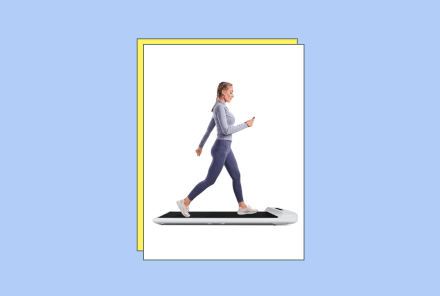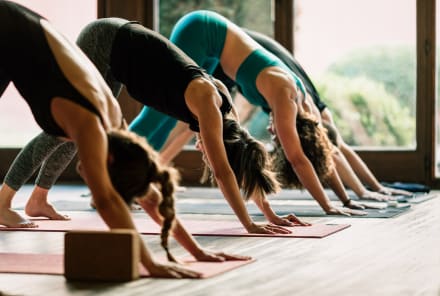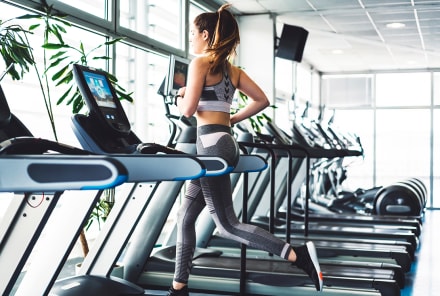Advertisement
A 15-Minute Yoga Flow To Create Space For The Changing Of Seasons

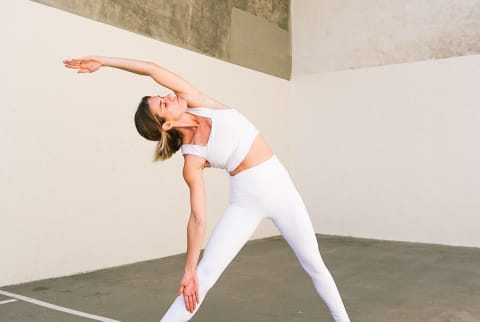
Even living in sunny Los Angeles, I find there is something extra cozy about transitioning into fall as a yogi. I notice my physical cravings start to shift from fast-paced vinyasa to slow and heated hatha. My asana practice becomes more soulful and embodied, as if my body knows it's time to turn inward and use the four corners of my mat as a space for reflection before we reach the end of the year.
I find myself more and more frequently playing with the duality of yin and yang energy as the days start to cool, incorporating heating pranayama, and exploring deeper ways to access opening through both physical poses and seated practices.
When we play with both the yin and the yang in our yoga practice, we experience balance through the body, mind, and breath. We welcome expansion on a physical and spiritual level and release the fast-moving energy of summer. In honor of this transition, I've curated a 15-minute yin and yang yoga flow for slowing things down, creating space, and shifting our frequency to honor the season of fall.
Three-Legged Downward-Facing Dog
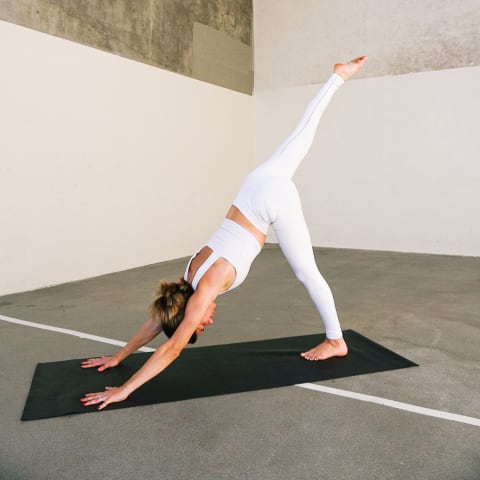
This is one of the building blocks of my practice and a pose that evokes patience and presence time and time again. It's easy to kick your leg up and move onto the next pose, but the true joy comes from treating this transitional movement as a pose within itself. By taking our time with the foundation, we set ourselves up for success when we shift into more challenging asanas.
How to:
- Start in downward-facing dog.
- Spread your fingers wide and press down through all 10 of your fingers to take the weight out of your wrists.
- As you inhale, extend one leg up toward the sky and focus on engaging through the inner thighs.
- Both hips should square down toward your mat. For support with squaring your hips, think about internally rotating or turning the inside edge of your thigh up.
- Press down equally through both the palms, and breathe here for two to three rounds of breath.
Side Plank Figure Four
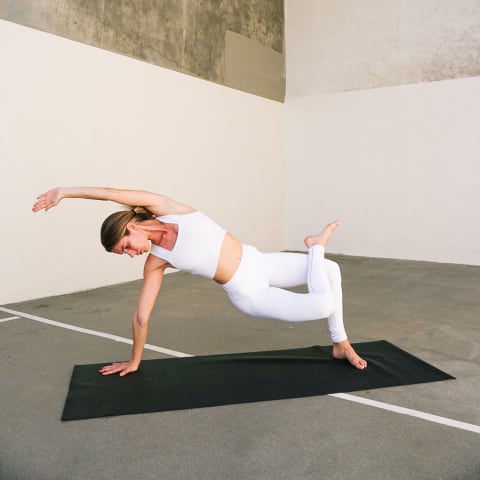
Summer might be over, but that doesn't mean that we can't incorporate playful energy into our lives throughout the fall and winter. I love combining common poses to add an extra challenge and foreign feeling in my body while I'm practicing, and this asana does exactly that. Between balancing, abdominal engagement, and hip opening, this side plank variation will become your new favorite pose to add in during your fall flows.
How to:
- From three-legged downward dog, pull the lifted knee into the chest.
- Bend into the grounded leg and shift the hovering ankle on top of the opposite thigh.
- Before moving any further, focus on pressing the thigh into the ankle and ankle into the thigh for opposing engagement.
- When you feel balanced and controlled, shift forward until the shoulders stack above the wrists.
- Bring your weight into the palm that is opposing the grounded leg and inhale the other arm overhead.
- When you're ready to come out, plant the lifted palm on the ground beneath the shoulder, lift the hips back up toward the sky, and release the hovered leg back into three-legged downward dog.
Open-Heart Crescent Lunge
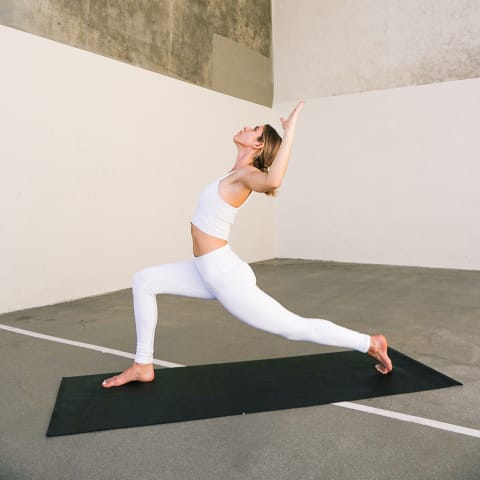
To intensify your practice, this asana will continue cultivating the yang energy that the previous poses in this flow have been building on. The duality between the lower body grounded and supported and the upper body open and expanded provides a symbol of balance that we can incorporate into our lives outside of the four corners of the mat.
How to:
- From three-legged downward dog, step the extended leg between the palms and into a low lunge.
- Gaze down and make sure the ankle is stacked directly beneath the knee, then shift your back heel forward until it is stacked above the ball-mound of your back foot.
- Press down through the feet and slowly inhale the palm and torso to standing in a high crescent lunge.
- Once the shoulders stack the hips, pull your front hip back and press your back hip forward.
- Relax your shoulders and inhale the fingertips an inch higher.
- As you exhale, cactus the arms to either side, press your hips forward, and lift the center of your chest toward the sky.
- Stay here for 2 to 3 rounds of breath using every inhale to create length along the spine and every exhale to expand through the chest.
Goddess Pose With Eagle Arms
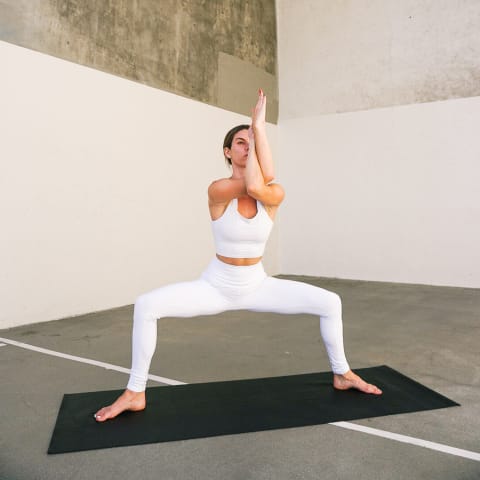
While challenging, this variation of goddess pose always provides a heating energy, intensity, and sense of surrender that feels natural as we transition into fall. Fall is a time for warm energy, finding solace in doing less, and reflection, and this pose offers us an opportunity to cultivate all of those qualities through our physical body.
How to:
- From high crescent lunge, straighten into the front leg and pivot the front toes in the same direction as the back.
- Bend deeply into the knees and energetically press the knees toward the pinky-toe-side edge of the feet so the hips open wide.
- As you inhale, reach the arms wide in opposite directions.
- As you exhale, wrap the right arm underneath the left and grab for opposite shoulders, or take a full bind bringing the palms to meet in the twist.
- Bring the elbows to shoulder height and press the palms away from the face so they stack above the elbows.
- Use 2 to 3 rounds of breath to continue sinking the hips low and pressing the knees wide.
Triangle Pose

This final yang-inspired posture of the flow brings the body back to basics while still evoking a fire within. Triangle pose is the perfect dash of cinnamon on top of a warming fall elixir as it gives the front leg a break before transitioning into the opposing side of the body and the second half of the flow. It requires awareness to maintain core strength, intentional breath, and alignment throughout the body.
How to:
- From goddess pose, straighten through both the legs and pivot the front toes toward the top of your mat.
- Extend the palms toward the front and back of your mat, then reach the front palm forward to create length along the side body.
- As you breathe out, shift the arms to 12 o'clock and 6 o'clock.
- Press the bottom palm into the inner edge of the thigh or calf and engage through the oblique of the side body.
- Stay here or reach the top bicep alongside the ear to add in the additional side body stretch.
Half Pigeon Pose
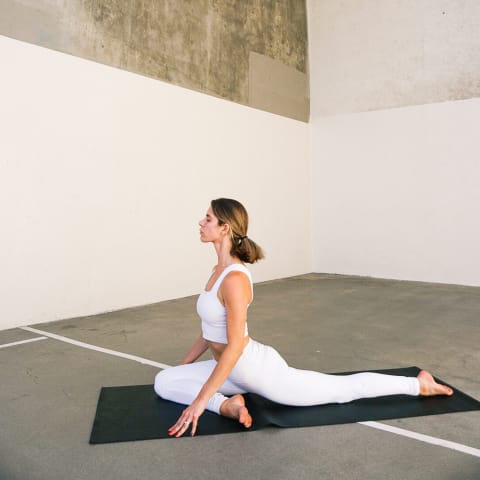
Half pigeon pose is the ultimate way to slow the body down and transition into the yin energy of the fall and winter months. It is deeply surrendering and offers an opportunity to observe the mind's relationship to physical sensation that runs throughout the body. Through this stillness we have an opportunity to let go of physical and emotional tension that we've been storing and create energetic space in the body and mind.
How to:
- From triangle pose, bring the palms down to frame the front foot and bend into the front knee.
- Toe-heel the front foot to the opposing wrist, then gently lay the shin down to parallel with the top of your mat.
- Relax the back knee down onto the earth, and walk the palms to frame the hips.
- Option to place a block or blanket underneath your hip or fold forward for more intensity in the stretch. Stay here for 10 rounds of breath, and try to practice complete stillness.
Kapalabhati Pranayama
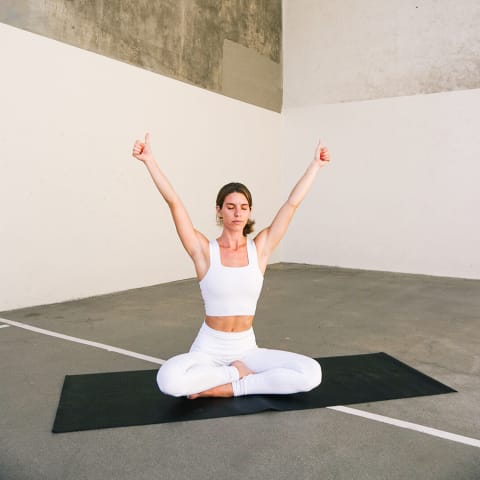
After finishing your fall yoga flow on both the right and left side, settle into a seated position to end your practice with pranayama. Kapalabhati, translated from Sanskrit is "skull-cleansing breath," and don't worry—it's not anywhere near as scary as it sounds! This practice has been used as a purifying technique and is an amazing way to end your practice feeling energized, heated from within, and clear in your mental and physical body. If you're pregnant or have cardiac problems, it is not recommended to practice this breathwork.
How to:
- In a seated position, create two fists with the palms, and release the thumbs.
- Bring the arms up into a V-shape, and relax the shoulders down your back.
- This style of breath is done all in and out of the nose, so seal the lips and inhale to first take a cleansing breath in and out.
- Then, inhale to fill the lungs about halfway.
- From there, exhale forcefully through the nose.
- As you breathe out, the belly button will suck in toward the spine.
- Your inhale will happen naturally as you relax the belly button away from the spine.
- Go at your own pace, and count 108 exhales to complete your practice.
Watch Next
Enjoy some of our favorite clips from classes
Enjoy some of our favorite clips from classes
What Is Meditation?
Mindfulness/Spirituality | Light Watkins
Box Breathing
Mindfulness/Spirituality | Gwen Dittmar
What Breathwork Can Address
Mindfulness/Spirituality | Gwen Dittmar
The 8 Limbs of Yoga - What is Asana?
Yoga | Caley Alyssa
Two Standing Postures to Open Up Tight Hips
Yoga | Caley Alyssa
How Plants Can Optimize Athletic Performance
Nutrition | Rich Roll
What to Eat Before a Workout
Nutrition | Rich Roll
How Ayurveda Helps Us Navigate Modern Life
Nutrition | Sahara Rose
Messages About Love & Relationships
Love & Relationships | Esther Perel
Love Languages
Love & Relationships | Esther Perel
